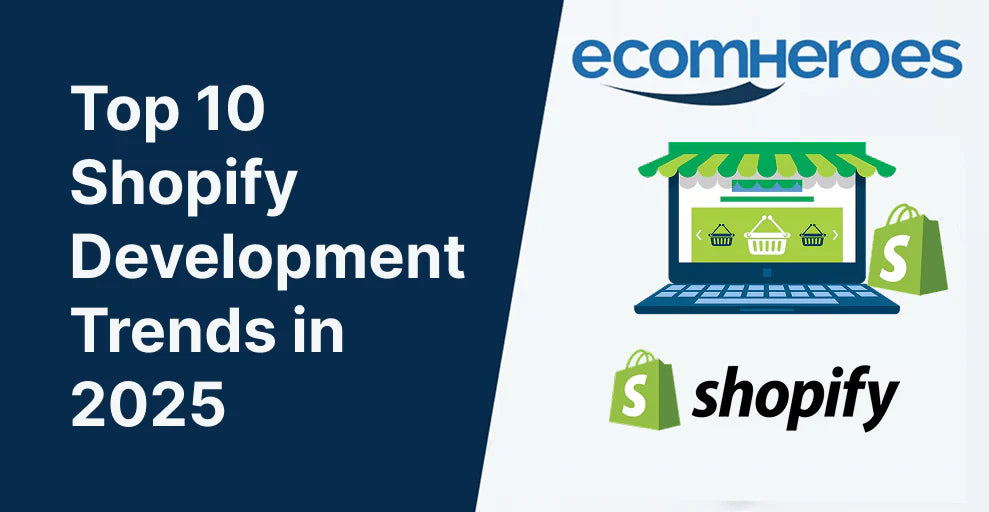Introduction
E-commerce is evolving at lightning speed, and Shopify remains one of the most popular platforms for online businesses. But as technology advances and customer expectations grow, it’s not enough to just have a Shopify store. To stay competitive in 2025, store owners and developers need to embrace the latest development trends that can enhance user experience, optimize performance, and boost conversions.
This year, the focus is shifting towards personalization, speed, mobile optimization, and seamless integrations. From headless development to AI-driven tools, Shopify is offering more possibilities than ever before. In this blog, we’ll explore the top 10 Shopify development trends for 2025. These trends aren’t just tech fads—they’re proven strategies that can help your store thrive in the increasingly competitive e-commerce landscape.
Whether you’re a developer looking to build cutting-edge stores or a business owner wanting to optimize your existing store, understanding these trends is essential. Let’s dive in and see what the future holds for Shopify development.
1. Headless Shopify Development
Headless commerce separates the front-end of your website (what customers see) from the back-end (Shopify’s core system). This separation allows for faster, more flexible, and highly customized user experiences.
Benefits:
-
Improved site speed and performance
-
Greater control over UI/UX
-
Easier integration with third-party tools
Example:
A fashion store can use React.js or Vue.js for a sleek, dynamic front-end while Shopify handles inventory, checkout, and payments in the backend. This setup allows developers to experiment with creative layouts without worrying about slowing down the store.
Trend Insight:
With more brands looking to offer unique experiences, headless development is expected to be a key focus in 2025. Shopify’s Storefront API makes it easier than ever to implement headless setups, even for small businesses.
2. AI-Powered Personalization
In 2025, customers expect stores to understand their preferences. AI-powered personalization is transforming Shopify stores by tailoring product recommendations, marketing messages, and content based on user behavior.
Examples of AI in Shopify:
-
LimeSpot: Suggests products based on browsing history
-
Personalizer AI: Customizes content for returning visitors
Why It Matters:
Personalized shopping experiences increase engagement, reduce bounce rates, and improve conversion rates. Customers are more likely to purchase when they feel the store “knows” them.
Implementation Tip:
Integrate AI apps early and analyze user behavior regularly to refine personalization algorithms.
3. Progressive Web Apps (PWA) for Shopify
PWAs bridge the gap between websites and native apps. They load quickly, work offline, and offer app-like experiences without requiring downloads.
Key Advantages:
-
Faster page load times
-
Offline access to store content
-
Push notifications to re-engage users
Example:
A store selling home decor can implement a PWA to allow customers to browse products even when offline. Notifications about discounts or new arrivals can be sent directly to the user’s device.
Trend Insight:
With mobile commerce dominating, PWAs will become increasingly popular, ensuring stores remain fast, responsive, and engaging.
4. Shopify Theme Development Innovations
Themes are no longer just templates—they are interactive, modular, and highly customizable.
Emerging Practices:
-
Modular layouts for quick experimentation
-
Lightweight code to enhance speed
-
Interactive animations and micro-interactions
Example:
A store selling gadgets can utilize a modular theme to test different homepage layouts, dynamically highlight new products, and adjust content based on the season or a specific campaign.
Pro Tip:
Focus on speed and usability while Shopify customizes themes to ensure customers enjoy a smooth experience.
5. Shopify App Ecosystem Expansion
Shopify’s app ecosystem is booming. Developers are releasing apps for inventory management, AI-powered marketing, AR/VR experiences, and personalized shopping.
Why It’s Important:
Apps allow stores to scale quickly without building everything from scratch.
Trending Apps:
-
AI chatbots for customer support
-
AR apps for product visualization
-
Subscription management apps for recurring revenue
Pro Tip:
Select apps carefully to avoid performance slowdowns and ensure seamless integration with your store.
6. Mobile-First Development
With more than 70% of traffic coming from mobile devices, Shopify developers are adopting mobile-first strategies.
Key Focus Areas:
-
Touch-friendly navigation
-
Fast mobile load times
-
Mobile-optimized images and content
Example:
A beauty store can design mobile layouts that highlight products, reviews, and promotions efficiently, ensuring users have a smooth shopping experience on any device.
Trend Insight:
Mobile-first design isn’t optional—it’s essential for higher conversions and SEO ranking.
7. Shopify SEO & Performance Optimization
SEO is evolving. In 2025, technical optimization, structured data, and fast loading times will be crucial.
Focus Areas:
-
Schema markup for products and blogs
-
Optimized images and lazy loading
-
Fast server response and caching
Pro Tip:
Use Shopify SEO apps like Plug in SEO and implement structured data to enhance search visibility.
8. Subscription & Membership Features
Recurring revenue is key to sustainable growth. Shopify stores are increasingly adopting subscription models.
Examples:
-
Monthly beauty boxes
-
Memberships for exclusive content
-
VIP programs for repeat customers
Why It Matters:
Subscriptions improve customer loyalty, predict revenue, and reduce marketing costs.
9. Advanced Checkout Customization
A smooth checkout can dramatically increase conversions. Shopify developers are innovating with:
-
One-page checkouts
-
Auto-filled addresses
-
Multiple payment options
Pro Tip:
Test checkout flows regularly to minimize cart abandonment and improve the user experience.
10. Integration with Emerging Payment Gateways
Payment trends are changing fast. Shopify stores need to support:
-
Cryptocurrencies
-
Buy Now Pay Later (BNPL)
-
Mobile wallets like Apple Pay & Google Pay
Why It Matters:
Offering multiple payment options builds trust, caters to younger audiences, and increases conversions.
Conclusion
2025 is shaping up to be an exciting year for Shopify development. From headless commerce and AI personalization to PWAs and advanced checkout optimizations, the trends are clear: speed, flexibility, and personalization are key.
By adopting these trends, you can build Shopify stores that not only look modern but also perform better, engage customers, and drive sales.
If you want your Shopify store built with all the latest 2025 trends, our expert developers can help. Contact us today to get started and future-proof your e-commerce business.





